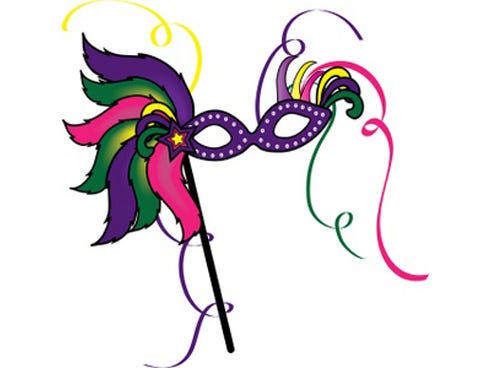
CRESTVIEW — In New Orleans and Mobile, Ala., folks are saying, “Laissez les bons temps rouler” — let the good times roll.
Mardi Gras doesn't roll in Crestview, but it could in the future.
“At the last committee meeting we had for the Crestview Centennial, we discussed doing a Mardi Gras parade,” Main Street Crestview Association member Cal Zethmayr said. “It takes a lot of time to put a Mardi Gras parade together. If we can do that in 2016, that could be the start of it going forward."
'NICE, FESTIVE ATMOSPHERE'
It won’t be the first time a local organization has floated the idea. In 2011, Main Street Crestview proposed a Mardi Gras parade among new events to attract people downtown.
Main Street President Ellis Conner said it’d be the perfect antidote for a dreary midwinter when little festivity occurs between the Christmas parade and the Triple B Cookoff.
“I thought it would be a great thing for coming out of a long winter, to get out and have a festive event where everybody can cut loose and catch their Moon Pies or beads or teddy bears or whatever,” Conner said. “It’s just a nice, festive atmosphere. It makes people feel better when they’re laughing and having a good time.”
While communities as close as Fort Walton Beach are celebrating Mardi Gras, family-friendly revelry is noticeably absent here even as some Carnival traditions, such as king cake, have come to town.
“A customer asked me, ‘Why is it that all the cities around Crestview do Mardi Gras but we don’t?’” News Bulletin account relations specialist Sherrie Stanley said.
“Newcomers expect us to have the same celebrations neighboring communities have.”
Mistaking the drunken, bosom-bearing revelry that occurs in a small section of the New Orleans French Quarter for what is mostly a family-friendly holiday, a few people once criticized Main Street’s suggestion and the proposal went nowhere.
Conner said he understands the concerns.
“I could see where some people would be a little offended by the event’s reputation, based on their beliefs,” he said.
Still, if Mardi Gras comes to Crestview, it won't be anything like the stereotypes.
"…It’s more of a kids and family event," Conner said. "They want those Moon Pies, teddy bears and beads.”
MARDI GRAS
The pre-Lenten festival that became Mardi Gras — literally “Fat Tuesday" — originated in medieval Rome and Venice before the French House of Bourbon (the noble family, not the beverage) embraced it.
Mardi Gras started in colonial America’s two most French of cities, New Orleans and Mobile, where by the early 1700s, Frenchmen and Creoles — French residents born in the colonies — observed the tradition of carnival “masques,” or elaborate balls.
By the 1830s, maskers in secret clubs and societies, the forerunners of today’s “krewes,” took to the streets in decorated carriages, their ways lit by “flambeaux,” servants carrying gas torches.
The holiday evolved into street festivals for the less genteel, making Mardi Gras a holiday that could truly appeal to all strata of society, as it does today.
Comus, the first New Orleans krewes, formed in 1856. By 1870, krewes began creating increasingly elaborate floats, called “tableaux cars,” from which trinkets and small-denomination coins were showered on throngs of eager parade-goers.
In 1875, by gubernatorial proclamation, Mardi Gras was declared a state holiday in Louisiana.
Mardi Gras officially begins on Twelfth Night, the last day of Christmas, and culminates at midnight on Fat Tuesday when Rex and Comus, the kings of their respective krewes, meet and toast.
Suddenly the joy and revelry come to a halt, as residents prepare for Ash Wednesday and the observance of Lent.
KING CAKE
The tradition of a pre-Lenten pastry is practiced all over the world. In Gulf Coast communities, including Crestview, the typical oval pastry is an oval cinnamon bread sprinkled with festive purple, green and gold-colored sugar.
Hidden within a king cake is a plastic baby, which traditionally represents the Baby Jesus. The person who gets the slice of king cake with the baby is considered blessed.
Traditionally, the blessed person must share their blessing by buying the next week’s king cake for their family or organization.
COLORS
Mardi Gras' official colors are purple for justice, green for faith and gold for power. King Rex established them in 1872 to honor visiting Russian Grand Duke Alexis Romanoff, whose House of Romanoff used the same colors.
People who do not mask — wear a costume — on Mardi Gras day are expected by etiquette to wear purple, green and gold.
THROWS
The tradition of tossing trinkets to the crowd started when Rex tossed medallions in 1884, the forerunner of today’s doubloons. Today, throws also include beads, which New Orleans tourists wear year-round, though locals know they should only be worn during Carnival.
Other throws include cups emblazoned with the krewe’s crest and parade theme art — called “Cajun crystal” by some — toys, stuffed animals, Moon Pies and even panties.
Email News Bulletin Staff Writer Brian Hughes, follow him on Twitter or call 850-682-6524.
This article originally appeared on Crestview News Bulletin: MARDI GRAS: No good times roll through Crestview — yet
